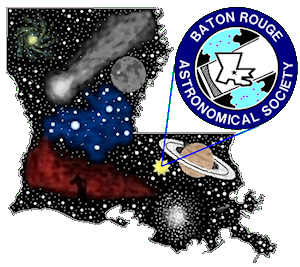
Dark Sky Advocacy
Light Pollution Defined
Light pollution is defined for BRAS’ purposes as “any artificial nighttime lighting present in an area where it is unneeded, unwanted or overly intense.”
The three main types of light pollution are usually agreed to be…
TREPASS --- The origin of this problem is a fixture whose light goes beyond the property or area for which the fixture was installed. This situation is usually accidental, either because the installer poorly angled the fixture and/or did not consider the property past the boundary of the property for which the light was meant. Popular examples include:
…a neighbor installing a security fixture which sends light onto adjacent properties and/or into the street
…businesses with security and/or parking fixtures which sends light onto adjacent properties and/or into the street
GLARE --- The origin of this problem is a fixture whose light goes into the eyes of people who, for whatever reason, must pass the fixture on a regular basis. A vast majority of glare examples in the Baton Rouge area come from business fixtures (parking lot fixtures or security fixtures) sending light straight into the eyes of passing motorists. Due to the low cost of extremely bright white LEDs, this problem has increased in the past two years.
SKY GLOW --- A majority of the damage to the professional astronomy industry and the amateur skygazing hobby caused by light pollution is caused by this subdivision. Sky glow is nothing less than light that is allowed to go straight up into the sky, or eventually reach the sky due to the fixture construction and/or angle of installation releasing some of its light at an angle higher than parallel to the ground. As astonishing as it sounds, there are numerous government, business, sport and security lights in the HRPO service area that create this hideous situation. The photons of light strike molecules of dust in the atmosphere. The illuminated dust creates an artificial canopy of grey/orange glow, blocking many celestial objects completely or dimming their apparent brightness.
The Negative Effects of Light Pollution
Hindrances to the Tasks Needed to be Performed by Professional Astronomers, and Those Needed to be Performed by Amateur Skygazers
Officially, this is the sole negative effects with which the Baton Rouge Astronomical Society is concerned. Astronomy and skygazing are centuries-old concerns. They have contributed to the understanding of our place in the Universe and have inspired musicians, poets and scientists in other fields.
The night sky is a ready-made STEM laboratory. It does not have to be purchased. It does not have to be assembled. There is no waiting list; fifty different people in Baton Rouge can observe simultaneously for fifty different reasons. It is BRAS’ responsibility to pass this interest to younger generations and to older people who have never experienced it.
Below are some other negative effects alleged to be created by light pollution. As the Baton Rouge Astronomical Society does not choose to make public statements regarding these issues, next to each effect is an organization to which BRAS suggest contact be made for more information.
- Hindrance to Nocturnal Habits of Animals
(Bluebonnet Swamp Nature Center, Louisiana Environmental Action Network) - Curbing of Night Vision of Drivers (Especially Older Drivers)
(Louisiana Department of Transportation and Development) - Slight Increase in Cancer Rates
(Louisiana Medical Society) - Increase in Electricity Bills
(local lighting providers)
Making Your Property Skygazing Friendly
The Baton Rouge Astronomical Society works with Public Works Departments, City Councils, schools and churches, sports fields managers and business owners to obtain a higher SQM rating (the higher the number the better). Simultaneously, you the homeowner can take action at your personal viewing grounds.
- Use a lower-wattage bulb housed within a fixture with a highly-reflective inside coating.
- Place all nighttime lighting on motion detectors.
- Request of your adjacent neighbors (including any behind you, e.g. the neighbor with which you share a backyard fence) that they also take the two actions above.
- Consider a non-white light (such as non-pest attracting yellow).
- Request of your electricity provider, city PW or homeowners association that any nearby street lighting not go on your property. This can be accomplished by the replacement of the street fixture, or its capping or shielding.
The Tests
The following deep-sky objects are listed in order from easiest to most difficult to see with unaided eyes.
- The Pleiades Star Cluster
- The Orion Nebula
- The Beehive Cluster
- Ptolemy‚s Cluster
- The Andromeda Galaxy
The Baton Rouge Astronomical Society (BRAS) advocates for better lighting practices and educates the community on the problem of light pollution. The club has given presentations to various government organizations, civic groups, libraries, Highland Road Park Observatory (HRPO) events, and at BRAS outreach events. BRAS and HRPO participate in the GLOBE at NIGHT citizen science project that tracks light pollution around the world. See the Light Pollution Forum on the BRAS web site - https://brastro.proboards.com/board/9/light-pollution-control, for more information on how BRAS is fighting light pollution.